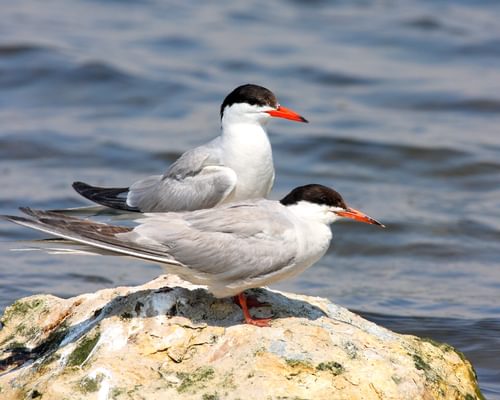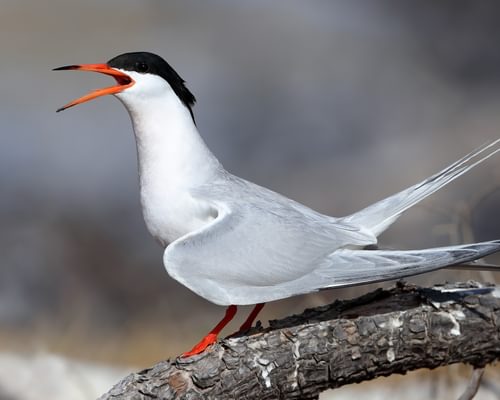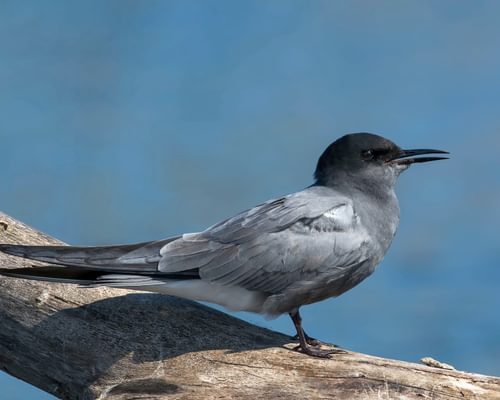Arctic Tern
Least ConcernSterna paradisaea
Visual Identification
Appearance
The Arctic Tern is a slender, medium-sized seabird with a distinctive appearance. Its plumage is predominantly white and pale grey, with a black cap extending to the nape. The bird's long, pointed wings and deeply forked tail contribute to its graceful, buoyant flight.
During the breeding season, adults sport a full black cap and bright red bill. Non-breeding adults have a white forehead and darker bill. Juveniles can be identified by their black-tipped wings and shorter tail streamers.
Size
Length
33cm to 39cm
Wingspan
76cm to 85cm
Weight
86g to 127g
Colours
Males and females have similar plumage
Primary Colour
White Grey
Secondary Colour
Black
Beak Colour
Red
Leg Colour
Red
Special Accolade
Marathon Migrator
Longest annual migration of any bird
Record: Annual round trip of 70,900 km (44,100 miles)
Habitat and Distribution
Habitats
Woodland
Garden
Wetland
Coastal
Urban
Farmland
Grassland
Desert
Tundra
Rainforest
Mountain
Savanna
Distribution
Arctic Terns have a circumpolar breeding distribution, nesting in coastal areas and tundra regions of North America, Europe, and Asia. They prefer open, treeless habitats near water, including rocky islands, beaches, and coastal tundra.
During the non-breeding season, Arctic Terns undertake an impressive pole-to-pole migration. They can be found along the coasts of South America, Africa, and Antarctica. In the UK, they breed along the northern and eastern coasts, with significant populations in Scotland.
Elevation Range
Sea level to 100 meters
Climate zones
Arctic, Temperate, Antarctic
Distribution Map
This map gives you a rough idea of where you might spot a Arctic Tern. The coloured areas show countries where these birds have been seen.
A few things to keep in mind:
- Birds might not be everywhere in the coloured areas, for example, they may be present around the coast of that country
- Where birds live can change with seasons and available food
- This map is quite simple - it doesn't show exact locations
We're working on making our maps even better! Soon, we hope to show you:
- More detailed maps for bigger countries, including state and region
- How birds move around during different seasons
Distribution by Region
Behaviour and Ecology
Bird Attributes
This feature is in beta. We'd love your feedback to improve it!
Share your thoughtsBird Attributes Explained
Our bird attributes system rates various aspects of a bird's capabilities on a scale of 0-100, based on data from field observations, scientific studies, and expert knowledge.
Attribute Categories:
- Agility: Manoeuvrability, speed, and grace in flight or movement.
- Strength: Physical power, often correlating with size and hunting abilities.
- Adaptability: Ability to thrive in various environments or changing conditions.
- Aggressiveness: Territorial behaviour and assertiveness, particularly during breeding seasons.
- Endurance: Stamina, often seen in migration patterns or foraging behaviours.
Understanding the Ratings:
- 0-20: Very Low
- 21-40: Low
- 41-60: Average
- 61-80: High
- 81-100: Very High
Remember, these attributes are relative to other bird species and don't necessarily indicate superiority.
Hover over the icon next to each attribute for more information.
Tap the icon next to each attribute for more information.
Agility
Reflects the bird's manoeuvrability, speed, and grace in flight or movement.
The Arctic Tern's exceptional agility is evident in its graceful, buoyant flight and ability to hover precisely before plunge-diving for fish. Its long, pointed wings and deeply forked tail contribute to remarkable manoeuvrability, essential for its pole-to-pole migration and hunting techniques.
Strength
Indicates the bird's physical power, often correlating with size and hunting abilities.
Whilst not particularly strong for its size, the Arctic Tern possesses sufficient strength to undertake its marathon migrations and carry fish to its young. Its ability to dive-bomb potential predators also indicates a respectable level of strength for its compact frame.
Adaptability
Represents the bird's ability to thrive in various environments or changing conditions.
The Arctic Tern demonstrates extraordinary adaptability, thriving in diverse environments from Arctic tundra to Antarctic waters. Its ability to navigate vast oceanic expanses, adjust to varied climates, and even sleep whilst flying showcases remarkable adaptability to challenging conditions.
Aggressiveness
Measures the bird's territorial behaviour and assertiveness, particularly during breeding seasons.
Arctic Terns exhibit high aggression, particularly during breeding season. They fearlessly dive-bomb potential threats, including much larger predators and humans, to protect their nests. This fierce territoriality is crucial for safeguarding their offspring in exposed coastal habitats.
Endurance
Reflects the bird's stamina, often seen in migration patterns or foraging behaviours.
The Arctic Tern's endurance is unparalleled in the avian world. Its annual pole-to-pole migration, covering up to 70,000 kilometres, represents the longest known animal migration. This incredible feat, sustained over a potential 34-year lifespan, firmly establishes the Arctic Tern as the epitome of avian endurance.
Diet
Arctic Terns primarily feed on small fish and marine invertebrates. They hunt by hovering above the water's surface before plunge-diving to catch their prey.
Their diet may also include small crustaceans and insects, particularly during the breeding season when they forage in coastal waters and tundra pools.
Behaviour
Arctic Terns are renowned for their agility in flight, often hovering gracefully before plunge-diving for fish.
They are fiercely territorial during breeding, fearlessly dive-bombing potential predators, including humans, that approach their nests. These birds are also highly social, often seen in large, noisy colonies during the breeding season.
Vocalisation
Arctic Terns are vocal birds, especially in their breeding colonies. Their most common call is a sharp, high-pitched 'kee-arr' or 'kip', often repeated rapidly when alarmed.
During courtship, they produce a softer, more musical 'krrrr-krrrr' sound, creating a cacophonous atmosphere in large colonies.
Nesting & Breeding
Arctic Terns typically form monogamous pairs, with courtship beginning shortly after arrival at breeding grounds in late spring. Males often present fish to females as part of their courtship display.
Nests are simple scrapes on the ground, sometimes lined with vegetation. Females usually lay 1-3 eggs, which are olive-brown with dark speckles, providing excellent camouflage.
Both parents share incubation duties for about 21-24 days. Chicks fledge after 21-28 days but continue to be fed by parents for several more weeks as they develop their flying skills.
Lifespan
The Arctic Tern typically lives for 13 years, with a maximum recorded lifespan of 34 years.
Like all birds, lifespan can be affected by factors including predation, habitat quality, disease, and access to food sources.
Conservation and Status
Global Conservation Status
While currently listed as Least Concern, Arctic Terns face threats from climate change, which affects their breeding habitats and food sources.
Ocean pollution, particularly plastic waste, poses a significant risk. Conservation efforts focus on protecting breeding sites and marine ecosystems along their extensive migratory routes.
Birdwatching Tips
- Look for Arctic Terns along coastal areas, especially near nesting colonies during summer months.
- Observe their distinctive, graceful flight pattern and listen for their sharp, high-pitched calls.
- In the UK, visit coastal areas in Scotland and Northern England for the best chances of spotting them.
- Use binoculars to distinguish their red bills and legs, which sets them apart from similar tern species.
Additional Information
Quick Facts
Other names:
Sea Swallow, Arctic Sea Tern
Family:
LaridaePredators
Did You Know?
- Arctic Terns can live up to 30 years and potentially cover over 2.4 million kilometres in their lifetime—equivalent to three round trips to the Moon.
- They experience more daylight than any other creature on Earth due to their pole-to-pole migration.
- Arctic Terns can sleep while flying, entering a state of half-sleep where one brain hemisphere remains alert.
Was this bird profile helpful?
Your feedback helps us improve our content
Thanks for your feedback!
Your input helps us improve our content.
Community Experience
Community Ratings
1 rating from birders
Latest Community Reviews
Yoshihiro Tanabe
Community Reviews
Create Your Free Account Welcome Back!
Join our community to rate birds and share your experiences. Creating an account is completely free and only takes a minute. Sign in to your account to rate birds and share your experiences with our community.
Your information is secure and will never be shared.
By creating an account, you agree to our Privacy Policy.
Similar Birds
References
- 2 4
website: BirdLife International. 2018. Sterna paradisaea. The IUCN Red List of Threatened Species 2018: e.T22694629A132065195.
View source - 1 3
report, 2015: Wetlands International


